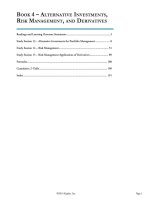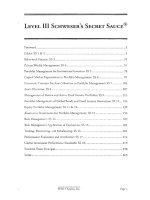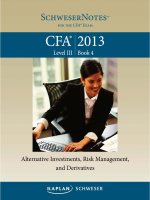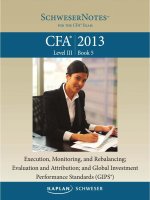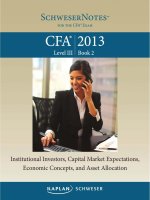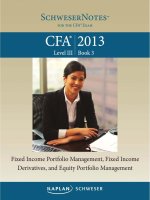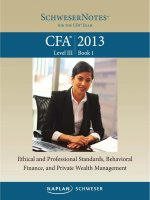2019 CFA level 3 qbank reading 10 managing individual investor portfolios questions
Bạn đang xem bản rút gọn của tài liệu. Xem và tải ngay bản đầy đủ của tài liệu tại đây (824.83 KB, 43 trang )
10/11/2018
Learning Management System
Question #1 of 95
Vivian Collins is a client of ESP Financial Advisors. She presents her situation as follows: Collins
is currently a divorced mother to a 5-year-old daughter, Daija. She is 35 years old. She has
worked at her current job with the government for the last 13 years, and assumes that she will
remain there until retirement and collect her pension. Collins wants to be able to send Daija to
the college of her choice. Collins expects her daughter to eventually marry and have children.
She would love to be able to leave something to these future grandchildren. How many time
horizons does Collins have?
.in
A) 4.
en
tre
B) 5.
Question #2 of 95
bo
ok
c
C) 3.
When planning for retirement, an individual investor may wish to use a Monte Carlo approach
m
over a deterministic approach because:
.o
A) Monte Carlo approaches are simpler and quicker to implement.
B) Monte Carlo approaches provide a better analysis of outcome ranges than the single
w
w
wealth gure estimate generated by deterministic approaches.
w
C) deterministic approaches use inappropriate inputs.
Question #3 of 95
Which of the following parts of an investment policy statement (IPS) is NOT considered a
constraint?
A) Time horizon.
B) Taxes.
C) Risk tolerance.
/>
1/43
10/11/2018
Learning Management System
Question #4 of 95
Which of the following statements about Monte Carlo simulation is CORRECT? Monte Carlo
simulation:
A) typically produces approximately 100 trials.
B) is best when it uses only historical data.
.in
C) forecasts a more accurate risk/return tradeo than a deterministic approach.
w
w
w
.o
m
bo
ok
c
en
tre
Question #5 of 95
/>
2/43
10/11/2018
Learning Management System
Carl and Terri Anderson, age 45 have a $1,500,000 investment portfolio. Given the following
investment policy statement, which of the potential portfolios would be most appropriate for
the Anderson's?
Ability to take risk:
The Anderson's have a long time horizon
and meet their current expenses through
current income. Their ability to take risk is
high.
Willingness to take risk:
Objectives
.in
bo
ok
c
Overall:
en
tre
Risk Tolerance
The Anderson's have stated that they do
not want to gamble with their money, but
are willing to take some risk to achieve their
investment goals, if they are adequately
compensated for that risk in the form of
expected return.
.o
m
High ability to take risk and moderate
willingness to take risk leads to a
moderately high risk tolerance.
w
w
w
Return
Objectives
Constraints
The Anderson's want to have a portfolio
worth $3,500,000 in today's dollars when
they retire in 20 years. They are planning to
spend their current income and do not plan
to make any further contributions to their
account. The break-even in ation rate
implied by TIPS is 2.5%.
Multistage, consisting of at least 2 time
horizons
Time Horizon
1. Retirement in 20 years
2. Retirement – at least 20 years after
retirement.
Liquidity
Requirements
Would like to keep $50,000 in cash on hand
at all times to meet emergency expenses.
Legal/Regulatory None
Taxes
Tax aspects should be considered and the
/>
3/43
10/11/2018
Learning Management System
bulk of retirement savings should be held in
a tax advantaged account.
None.
Portfolio 1
Portfolio 2
Portfolio 3
Large cap U.S. Stocks
8%
20%
36%
15%
Small cap U.S. stocks
12%
10%
10%
15%
International
developed market
equities
11%
10%
10%
International
emerging market
equities
15%
U.S. corporate bonds
U.S. Treasury bonds
Venture capital
Cash (T-bills)
0%
5%
20%
35%
35%
4%
22%
0%
30%
20%
10%
0%
0%
3%
3%
4%
5%
8.62%
7.80%
6.10%
12.80%
10.20%
7.40%
w
w
.o
Standard deviation
5%
m
Total expected return
0%
5%
bo
ok
c
Asset Class
.in
Asset
Class
Return
en
tre
Unique
Considerations
A) Portfolio 3.
w
B) Portfolio 1.
C) Portfolio 2.
Question #6 of 95
/>
4/43
10/11/2018
Learning Management System
Jessica Paskiet, a portfolio manager for Porthouse Investment Management is drafting an
investment policy statement for her new client, Kenneth Moon. Which of the following
procedures should Paskiet follow when drafting the risk and return objectives for her client?
Procedure
1:
Consider the client's risk tolerance and return objective
separately from one another.
Procedure
2:
Focus on the investor's required returns only, as desired
returns are not important when drafting the IPS.
With regard to the procedures Paskiet has proposed:
Incorrect
B) Incorrect
Correct
C) Incorrect
Incorrect
Question #7 of 95
bo
ok
c
A) Correct
.in
Procedure 2
en
tre
Procedure 1
m
Steve Smith is 55 years old. He has just been promoted to VP of manufacturing of a well
established manufacturing conglomerate. Recently, Smith received a substantial inheritance
.o
from a wealthy relative. Given this information, how would Smith be classi ed along a risk
w
w
tolerance spectrum?
A) Low-to-moderate.
w
B) Moderate-to-high.
C) Not enough information to tell.
Question #8 of 95
Which of the following sets of assumptions is most relevant to the behavioral nance
investment framework? Investors are:
/>
5/43
10/11/2018
Learning Management System
A) loss averse, investors exhibit biased expectations, investors construct portfolios via
asset segregation.
B) risk averse, investors demonstrate rational expectations with respect to investment
choices, investors construct portfolios consistent with asset integration.
C) risk averse, investors exhibit biased expectations, investors construct portfolios via
asset segregation.
.in
Question #9 of 95
The investment policy statement:
en
tre
Which of the following statements concerning an investor's policy statement is least accurate?
A) provides guidance to the investment advisor regarding issues of appropriateness of
decisions.
bo
ok
c
B) determines the client's ability and willingness to take risk.
m
C) should represent the return objectives of the investor.
.o
Question #10 of 95
w
w
Which of the following statements regarding situational pro ling is least accurate?
A) With situational pro ling, the source of an investor's wealth is considered an indicator
w
of the investor's risk tolerance.
B) When properly used, situational pro ling will provide a great degree of insight into an
investor's preferences, economic situation, goals, and desires.
C) Situational pro ling considers an individual's preferences, economic resources, goals,
and desires.
Question #11 of 95
/>
6/43
10/11/2018
Learning Management System
Investor behavior and psychology allow classi cation according to risk preferences. The
particular technique associated with this classi cation exercise is termed personality:
A) assessing.
B) typing.
C) testing.
.in
Question #12 of 95
Dan Kreuz, age 35, is a supervisor with BHS Consumer Finance and earns an annual salary of
en
tre
$95,000 per year before taxes. His spouse, Szeren Kreuz, age 36, is a marketing manager for a
rm specializing in rental property, and earns $55,000 per year. Dan and Szeren recently
inherited $800,000 from Szaren's father's estate. In addition to their income and their
inheritance, the Kreuz's have accumulated the following assets:
bo
ok
c
$10,000 in cash
$150,000 in stock and bond mutual funds
$240,000 in BHS common stock.
The Kreuz's annual living expenses are $90,000 per year and their tax rate is 40 percent. After-
m
tax salary increases will o set any future increases in living expenses. In a discussion with their
.o
nancial advisor, Joel Douglas, the Kreuz's express concern about having enough assets for a
w
w
comfortable retirement. The Kreuz's make the following comments to Douglas:
We want to retire in 20 years.
We were very uncomfortable with the decline in the stock market from 2000-2002, and
w
cannot tolerate a drop in our investments of more than 10% in any given year.
We do not plan to have children.
After the discussion with Douglas, he goes back to his o ce to prepare an investment policy
statement for the Kreuz's. He determines that to meet their goals, they will need $2,500,000 in
20 years. Which of the following is the most appropriate description of the risk objective for the
Kreuz's?
Willingness to Take
Risk
A) Below Average
Ability to Take Risk
Above Average
Overall Conclusion
Above Average
/>
7/43
10/11/2018
Learning Management System
B) Below Average
Below Average
Below Average
C) Below Average
Above Average
Below Average
Question #13 of 95
Gary Daly is a retired schoolteacher who invests most of his money in U.S. Treasury bonds and
notes. He has often stated that in times of crisis, he feels that it is better to be safe than sorry.
.in
In terms of behavioral nance, Daly is exhibiting which personality type?
A) Cautious.
en
tre
B) Methodical.
Question #14 of 95
bo
ok
c
C) Spontaneous.
Which of the following statements about risk and decision-making styles would least likely
m
appear in a personality typing questionnaire?
.o
A) I do not like contact sports, like football.
w
w
B) I typically lose sleep when the market is down.
w
C) My favorite subject in school was mathematics.
Question #15 of 95
Which of the following represents the process involved in creating an investment policy
statement?
A) Evaluate objectives, capital market expectations, and investment strategies.
B) Evaluate objectives and constraints and combine them with capital market
expectations.
C) Determine constraints and formulate investment strategies.
/>
8/43
10/11/2018
Learning Management System
Question #16 of 95
Which of the following statements distinguishes the ability to take risk from the willingness to
take risk? The:
A) willingness to take risk is connected with primary goals and objectives.
B) ability to take risk is more amenable to quantitative measures whereas the willingness
to take risk is more qualitative in nature.
C) ability to take risk is more qualitative in nature whereas the willingness to take risk can
en
tre
.in
be measured in a quantitative nature.
Question #17 of 95
A) individual selections.
bo
ok
c
Behavioral nance models of asset pricing take into account economic considerations and add:
B) security speci c characteristics.
w
w
.o
m
C) personal preferences.
Question #18 of 95
w
Which class of liquidity constraints is usually NOT considered a factor when formulating an
individual's investment policy statement?
A) Ongoing expenses.
B) Negative liquidity events.
C) Cash carried on the person.
Question #19 of 95
/>
9/43
10/11/2018
Learning Management System
Which of the following inputs is NOT used in both deterministic and probabilistic analyses in
individual retirement planning?
A) Current income.
B) Input variable probabilities.
C) Assets owned.
.in
Question #20 of 95
Larry Smith, CFA, is the new equity portfolio manager for a socially responsible mutual fund.
en
tre
The investment policy statement stipulates which stocks do not meet the fund's de nition of
socially responsible. Because Smith was new to the fund, he did not personally agree to the
stocks that were forbidden. Subsequently, he included a stock into the portfolio that was on the
restricted list. Which of the following statements is least accurate?
prior to stock selection.
bo
ok
c
A) Smith was responsible for reading and understanding the investment policy statement
B) Smith is to be held responsible for the investment policy statement even though it was
written before he was employed at the fund.
w
w
.o
m
C) Smith did not violate the investment policy statement.
w
Question #21 of 95
Which of the following statements about appropriate investment planning is CORRECT?
A) Individual investment planning could include the consultation of counsel.
B) It is not a good idea to get too speci c when constructing an investment policy
statement.
C) An appropriate investment objective for a typical 23-year-old investor is a low-risk
strategy, such as capital preservation.
/>
10/43
10/11/2018
Learning Management System
Question #22 of 95
The results of a personality typing questionnaire can be used to classify investors according to
risk tolerance and how decisions are made. The classi cation that represents the most risk
averse investor would be a(an):
A) methodical investor.
B) spontaneous investor.
.in
C) cautious investor.
en
tre
Question #23 of 95
Kent Andling is 55 years old and recently sold his high tech manufacturing company, which was
started in his father's basement 35 years ago. Andling's two children are grown and have been
bo
ok
c
featured in recent entrepreneur magazine articles as up and coming entrepreneurs. How would
Andling be classi ed given this brief pro le?
A) Low-to-moderate risk tolerant.
B) Not enough information to tell.
w
w
.o
m
C) Moderate-to-high risk tolerant.
Question #24 of 95
w
Which of the following is NOT determined using situational pro ling? Investor:
A) philosophy.
B) behavior.
C) biases.
Question #25 of 95
The ability to take risk is best judged by:
/>
11/43
10/11/2018
Learning Management System
A) the time horizon of long term needs and goals.
B) the time horizon of both short- and long-term needs and goals.
C) the time horizon of only short term needs and goals.
Question #26 of 95
The concept of behavioral nance has begun to be employed in investment management.
Which of the following statements is CORRECT regarding behavioral nance and its potential
.in
a ect on a client's risk objectives? Behavioral nance implies that investors are:
en
tre
A) risk averse, rather than loss averse, and this may have an impact upon the investors'
willingness to take risk.
B) loss averse, rather than risk averse, and this may have an impact upon the investors'
willingness to take risk.
bo
ok
c
C) loss averse, rather than risk averse, and this may have an impact upon the investors'
m
ability to take risk.
.o
Question #27 of 95
w
w
When investors choose riskier investments over less risky choices in the domain of losses, they
exhibit which of the following characteristics?
w
A) Risk aversion.
B) Asset segregation.
C) Loss aversion.
Question #28 of 95
/>
12/43
10/11/2018
Learning Management System
Dan Newsmith is 35 and was recently promoted to regional sales manager of a national trading
company. Newsmith has no credit card debt, he does not have an automobile loan, and his
home is mortgage free. Newsmith's salary and bonus more than adequately cover living
expenses. Given this brief pro le, classify Newsmith's ability to tolerate risk when investing
excess funds.
A) Low-to-moderate risk tolerance.
B) Not enough information to tell.
.in
C) Moderate-to-high risk tolerance.
w
w
w
.o
m
bo
ok
c
en
tre
Question #29 of 95
/>
13/43
10/11/2018
Learning Management System
Bill Kelley, age 55, just retired and accepted an early retirement package from his employer,
FertileGro Lawncare. The early retirement package has an estimated value of $1.2 million after
taxes. After taking the retirement package, Kelley took a job in customer service at a local
hospital and currently has a salary of $50,000 per year. Sharon Kelley, age 54, works part-time
as the Treasurer for their church and has a salary of $15,000 per year. They have two children,
Shannon, age 31, and Sarah, age 18. Shannon is married and does not require nancial
assistance, while Sarah is in her rst year of college. The Kelleys consider the early-retirement
package a wonderful addition to their existing $2 million in savings. They have no debt and pay
their expenses on monthly basis. Total family expenses last year including tuition amounted to
approximately $93,750.
.in
Bill and Sharon Kelley recently approached Modern Portfolio Management, Inc. for help in
managing their portfolio. At a recent fact- nding meeting, the Kelleys made the following
en
tre
statements:
Our primary goal is to pay for the college education of our youngest daughter, Sarah.
Tuition, room, and board last year was $30,000 and is expected to grow at 5% per year.
bo
ok
c
We want to retire at age 65 and live comfortably.
We are taxed at a 25% rate on dividends, capital gains, and income.
In ation is expected to grow at 2.5% per year inde nitely.
People get too excited about the stock market - they talk about making all of this money,
but they could turn around and lose it tomorrow. We don't want to be in any individual
m
investment or security that is considered too risky.
.o
We do not foresee any unusual expenses, but like to keep some cash on hand, just in
w
w
case of emergencies.
Modern Portfolio Management presents the Kelleys with three model portfolios. Which of the
w
portfolios would be best suited for the Kelley's to meet their living expenses this year?
Asset Class
Portfolio 1
Portfolio 2
Portfolio 3
Large cap U.S. stocks
20%
35%
15%
Small cap U.S. stocks
10%
15%
0%
International developed market
equities
5%
10%
0%
International emerging market
equities
5%
5%
0%
U.S. corporate bonds
20%
30%
45%
U.S. Treasury bonds
10%
0%
20%
/>
14/43
10/11/2018
Learning Management System
Real estate
5%
0%
0%
Venture capital
10%
0%
0%
Cash
15%
5%
20%
Total expected return
6.8%
6.3%
5.1%
Current yield
3.8%
3.5%
4.6%
A) Portfolio 2.
B) Portfolio 1.
.in
C) Portfolio 3.
en
tre
An analyst is developing an investment policy statement for Sally Edgewood, a 48-year old
orthodontist with an annual income in excess of $400,000. Edgewood has accumulated an
investment portfolio with a current value of $4 million. Her portfolio is concentrated in small
capitalization stocks with a bias toward high-tech companies. She has expressed a desire to
bo
ok
c
earn a return equal to the return of 12 percent above the return of the Russell 2000 small
capitalization stock index. Edgewood lives well on 50 percent of her annual income. She has
always been a ski enthusiast and this year she plans to purchase a second home in the
mountains in western Wyoming. This purchase will be mortgaged and require her to make an
m
$80,000 down payment. Edgewood plans to retire at the age of 63 and is currently paying taxes
.o
at a rate of 30 percent on both income and capital gains.
w
w
Question #30 of 95
w
Which of the following most accurately portrays Edgewood's overall risk tolerance? Edgewood's
willingness:
A) and ability to accept risk is above average. Thus, her overall risk tolerance is above
average.
B) to accept risk is above average and her ability to accept risk is average. Thus, her overall
risk tolerance is average.
C) to accept risk is average and her ability to accept risk is above average. Thus, her overall
risk tolerance is average.
/>
15/43
10/11/2018
Learning Management System
Question #31 of 95
Which of the following most accurately describes Edgewood's tax, liquidity, and time horizon
constraints? Edgewood's overall time horizon is:
A) long, her tax constraints are signi cant, and her liquidity needs are low.
B) short, her tax constraints are signi cant, and her liquidity needs are low.
C) long, her tax constraints are signi cant, and her liquidity needs are high.
.in
Barbara Analee, a retired registered nurse and business woman, recently retired at age 50 to
pursue a life as a blues singer. She had been running a successful cosmetics and aesthetics
en
tre
business using state-of-the-art lasers to treat wrinkles and skin blemishes. She is married to
Tom, a retired scientist (age 55). They have saved $3 million in their portfolio (Barbara
contributed $2.5 million to this portfolio) and now they want to travel the world. Their three
children are all grown and out of college and have begun to have their own families. Barbara
bo
ok
c
now has two grandchildren. Barbara and Tom feel that they have achieved a comfortable
portfolio level to support their family's needs for the foreseeable future.
In order to meet their basic living expenses, Tom and Barbara feel that they need $75,000 per
year in today's dollars before taxes to live comfortably. As a trained professional, Barbara likes
m
to be intensively involved in researching investment opportunities. Barbara and Tom want to
be able to provide $10,000 per year (pretax) indexed for in ation to each of their grandchildren
.o
over the next ten years for their college education. She believes that she can accomplish this
w
w
through her portfolio. She also wants to set aside $15,000 each year (pretax) indexed for
in ation for traveling for her musical performances at various dinner clubs around the U.S.
They have no debt and they own their home without a mortgage. Most of their portfolio is
w
currently in large cap U.S. stocks and U.S. Treasury notes and bills.
They have approached Pamela Jaycoo, CFA, for guidance on how they could best achieve their
nancial goals while also providing for their grandchildren's college needs. In ation is expected
to stay at 3 percent annually for the foreseeable future.
Question #32 of 95
Barbara Analee can be classi ed into which of the following personality types?
A) Methodical investor.
/>
16/43
10/11/2018
Learning Management System
B) Cautious investor.
C) Individualist investor.
Question #33 of 95
What is the Analees return objective for this year?
A) 6.17%.
.in
B) 6.67%.
en
tre
C) 3.83%.
What is their tolerance for risk?
A) Average.
B) Below average.
w
w
.o
m
C) Above average.
bo
ok
c
Question #34 of 95
w
Question #35 of 95
What is Barbara's willingness and ability to assume risk?
Willingness
Ability
A) Above average
Average
B) Above average
Above average
C) Below average
Average
/>
17/43
10/11/2018
Learning Management System
Question #36 of 95
Based on the information presented in the case above, which one of the following portfolios
Expected
Return
Portfolio A
Portfolio B
Portfolio C
U.S Stocks - S&P 500
9%
20%
5%
10%
U.S Stocks - Small Cap
10%
20%
15%
10%
Intl Stocks Developing
12%
15%
15%
10%
U.S Corporate Bonds
5%
15%
U.S Treasury Bonds
3%
10%
.in
should the Analees choose:
Venture Capital
11%
Real Estate
15%
Cash
1%
0%
25%
5%
30%
0%
10%
30%
0%
5%
5%
10%
8.8%
11.6%
5.7%
5.6%
7.4%
3.6%
1.9%
1.9%
2.8%
en
tre
35%
bo
ok
c
.o
m
Total Return (before
taxes)
Total Return (after
taxes)
0%
w
w
Yield (after taxes)
A) Portfolio C.
w
B) Portfolio B.
C) Portfolio A.
Question #37 of 95
/>
18/43
10/11/2018
Learning Management System
For this question only, assume that Barbara has accepted an o er to work part-time as a
lounge singer in Las Vegas for the next ve years but still continue with her traveling as a blues
singer. This position will pay her a gross income of $45,000 annually. However, the Analees
annual living expenses will increase to $85,000. After ve years, Barbara plans on returning to
retirement at which point, the Analees living expenses will return to 75,000 per year in today's
dollars. Also assume they will live for 30 more years at which time the portfolio will be
completely spent down.
Based on this new information, what is the Analees return objective?
A) 2.39%.
.in
B) 6.97%.
en
tre
C) 6.48%.
Jennifer Moore has worked in a governmental position (administrative assistant) since
bo
ok
c
graduating from high school. She loves her job because she is very good at following her
bosses' orders. At o ce functions, many of her colleagues ranted and raved about the quality
of her baked goods. Some even suggested that they tasted so good that she should quit her job
and sell baked goods. Moore is 50 years old and never paid attention to the suggestions of her
m
colleagues. She plans on retiring from the government in three years.
.o
Question #38 of 95
w
w
Based on her personality type, what type of investor is Moore?
w
A) Cautious.
B) Methodical.
C) Individualist.
Question #39 of 95
Jennifer Moore recently came into a seven- gure inheritance from a long-lost uncle. Which of
the following statements about Moore is most accurate?
/>
19/43
10/11/2018
Learning Management System
A) Moore has little to no familiarity with risk taking and will tend to be more cautious in
her investment approach.
B) She will be willing to take an active role in the investment process.
C) Since she didn't count on the inheritance, she will be willing to take on substantial
investment risks.
Question #40 of 95
.in
Investor psychology indicates investors will form portfolios via which method?
en
tre
A) Triangulating.
B) Pyramiding.
Question #41 of 95
bo
ok
c
C) Integrating.
m
Although legal and regulatory constraints do not usually impact an individual investor's policy
statement, attention must often be paid between two parties of personal trusts. Which parties
.o
exhibit the greatest tension in setting investment policy for a personal trust?
w
w
A) Income bene ciary and remaindermen.
B) Grantor and remaindermen.
w
C) Income bene ciary and the trust o cer.
Question #42 of 95
/>
20/43
10/11/2018
Learning Management System
Anthony Scarillo, a mortgage broker, is considering investing all his savings into a mutual fund.
He will take above-average risk in exchange for the possibility of outperforming the market.
Scarillo is 60 years old. Based on this information, which of the following two funds is most
appropriate for him?
Mutual Fund A
Mutual Fund B
Growth
Five year return 12%
Five year return 14%
Standard deviation = 7
Standard Deviation = 12
Consists of 40% growth stocks,
60% preferred stocks
Consists of 100% growth stocks
en
tre
A) B, because of its higher ve year return.
.in
Balanced
B) A, because of its ability to beat in ation at a lower standard deviation.
Question #43 of 95
bo
ok
c
C) A, because of its higher income.
m
When constructing an investment policy statement (IPS), which of the following statements
.o
would be considered least accurate?
w
w
A) The use of total return analysis is almost always the wrong way to approach an IPS.
B) If there are liquidity requirements, the applicable after-tax return will need to be
w
calculated.
C) One of the distinguishing factors between individual and institutional investors is time
horizon.
Question #44 of 95
Which of the following personality types applies to investors who make investment decisions
based on facts as opposed to their feelings or intuitions?
A) Methodical and individualist.
/>
21/43
10/11/2018
Learning Management System
B) Methodical and cautious.
C) Spontaneous and methodical.
Question #45 of 95
Which of the following is a reason why psychological pro ling is important for understanding
individual investor behavior? Investors:
.in
A) are assumed to only select portfolios that maximize a return for a given level of risk.
B) are loss averse.
Question #46 of 95
bo
ok
c
interacts with other assets in the portfolio.
en
tre
C) focus on individual asset risk/return characteristics as well as how the individual asset
An investor's source of wealth is often considered important in determining attitudes towards
risk taking. Which source of wealth is considered commensurate with greater risk tolerant
m
pro les?
.o
A) Actively acquired sources of wealth.
w
w
B) Passively acquired sources of wealth.
w
C) Inherited sources of wealth.
Question #47 of 95
Which of the following items is not considered a constraint in constructing an investment policy
statement?
A) Risk.
B) Liquidity.
C) Taxes.
/>
22/43
10/11/2018
Learning Management System
Question #48 of 95
The results of a personality typing questionnaire can be used to classify investors according to
risk tolerance and how decisions are made. The classi cation that represents investors
su ering the highest trading costs is:
A) individualist investors.
B) spontaneous investors.
en
tre
.in
C) methodical investors.
Question #49 of 95
bo
ok
c
An investment policy statement does NOT provide which of the following?
A) Guaranteed investment returns.
B) Weighting ranges for asset allocation.
.o
m
C) Long-term investment decision making guidelines.
w
w
Question #50 of 95
Which of the following statements regarding institutional and individual investors is CORRECT?
w
A) Institutions and not individual investors should focus on total return.
B) Time horizon factors are typically more crucial to individuals than institutions.
C) Portfolio growth is not important when an individual client is faced with substantial
income requirements.
Question #51 of 95
/>
23/43
10/11/2018
Learning Management System
With respect to the constraints portion of an investor's investment policy statement, issues
relating to on-going expenses, emergency reserves, alterations in on-going expenses, and
transactions costs are all examples of:
A) liquidity issues.
B) time horizon issues.
C) unique circumstances.
.in
Question #52 of 95
en
tre
Behavioral nance indicates investors do NOT exhibit which of the following?
A) Asset integration.
C) Biased expectations.
m
Question #53 of 95
bo
ok
c
B) Asset segregation.
.o
Most of the short questionnaires used by investment professionals to determine client risk
w
w
tolerance levels consist of:
A) comments about investment scenarios.
B) questions that focus on how the individual would deal with the professional if he/she
w
lost their money.
C) comments about non-investment scenarios.
Question #54 of 95
An investment policy statement bene ts investment advisors because it provides:
A) an understanding of the advisory relationship between manager and client.
B) guaranteed legal protection against errors in omission lawsuits.
/>
24/43
10/11/2018
Learning Management System
C) guidelines for capital market expectation formations.
Sam and Ellen Smithson have both recently retired after numerous years of working as a heart
surgeon and pediatrician, respectively. The Smithsons were not able to have children, so they
devoted their lives to helping others through their professional and charitable activities. Sam
was involved in the local "Pantry Pass," an organization that gathered food items for
distribution to the needy. Ellen was involved in her local "Housing for the Homeless," chapter.
Both served their respective organizations in direct service and board member capacities.
The Smithsons's professional activities generated high incomes that were beyond living
.in
expenses, which could easily be described as comfortably frugal. Over the years, a tax deferred
en
tre
retirement savings account in the amount of $4,000,000 has been accumulated. During
discussions with Marcus Medley, CFA, Sam and Ellen mentioned the following:
Our living expenses are minor and are estimated to be no greater than $150,000 per
year. As a result, we consider our retirement portfolio to be large both in absolute and
bo
ok
c
relative terms
We are both in good health and have at least another 20 to 25 years of life expectancy.
We do not foresee any major medical expenses, either chronic or acute, over the
horizon.
We have no debts and wish not to undertake decisions that would require us to borrow.
m
After we die, we would like to leave the remainder of our portfolio equally to the charities
.o
with which we have been involved over all these years. One of our objectives is to
w
w
maximize those funds transferred.
Neither one of us has a high tolerance for risk and, for the most part, our retirement
savings have been in low-risk type investment vehicles. Our investment portfolio
w
decisions have been made in congruence with our feelings of enhancing the
opportunities available to our fellow man.
When we have invested in equity-type securities, we have focused investing in socially
responsible funds. Firms that sell tobacco, rearms, alcohol, or have been cited by the
EPA for environmental damage are not allowed in our portfolio.
Medley has taken the Smithsons' personal statements, as well as economic activity forecasts,
and is attempting to formulate an investment policy statement, as well as recommend some
general asset allocation guidelines.
Question #55 of 95
/>
25/43
